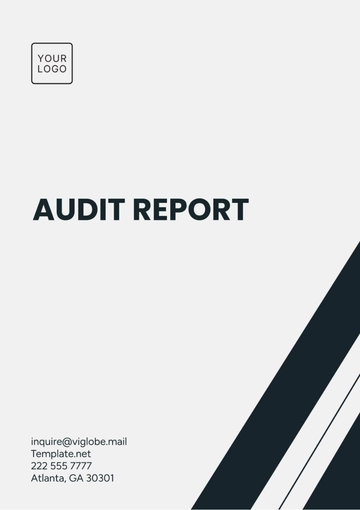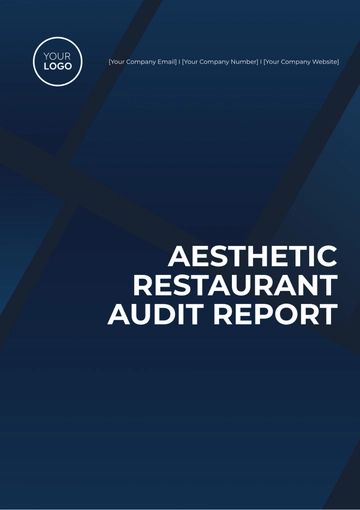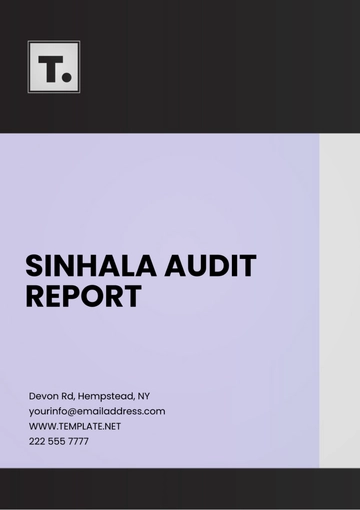Free Business Audit Outline Report

I. Introduction/Overview
The purpose of this Business Audit Outline Report is to provide a structured framework for conducting an internal audit of [Your Company Name]'s financial, operational, and compliance activities. This audit aims to assess the company's effectiveness in meeting its strategic objectives, ensure legal and regulatory compliance, and identify areas for improvement. The audit will help in providing stakeholders with an accurate assessment of the organization's performance and efficiency.
II. Audit Scope
The audit will focus on the following key areas of the business:
Financial Records: Evaluation of financial statements, accounting practices, and internal controls.
Operational Efficiency: Review of processes, resource allocation, and performance metrics.
Compliance: Assessing adherence to legal and regulatory standards relevant to the industry.
Risk Management: Analyzing the company's risk assessment framework and mitigation strategies.
Internal Controls: Reviewing policies and procedures to safeguard assets and prevent fraud.
III. Methodology
The audit will follow a systematic approach, ensuring that data is collected, analyzed, and evaluated thoroughly. The key steps include:
Data Collection: Gathering relevant financial documents, operational reports, and compliance records.
Interviews and Surveys: Conducting interviews with key personnel and distributing surveys to gather insights on processes and potential issues.
Sampling and Testing: Performing tests on financial transactions and operational processes to verify accuracy and compliance.
Benchmarking: Comparing business performance against industry standards or similar organizations.
Documentation Review: Analyzing internal policies, procedures, and previous audit reports.
IV. Audit Timeline
The audit will be conducted over 8 weeks, with the following key milestones:
Week 1-2 (January 1 - January 14): Initial planning and data collection.
Week 3-4 (January 15 - January 28): Fieldwork, including interviews, testing, and process reviews.
Week 5 (January 29 - February 4): Analysis of findings and formulation of recommendations.
Week 6 (February 5 - February 11): Drafting of the final audit report.
Week 7 (February 12 - February 18): Presentation of audit results to management and stakeholders.
V. Risk Assessment
The risk assessment will evaluate both the likelihood and potential impact of various risks within the company. Key risks to consider include:
Financial Mismanagement: Inaccurate financial reporting or ineffective internal controls.
Regulatory Non-Compliance: Failure to adhere to industry laws or standards, which may result in penalties or legal consequences.
Operational Inefficiencies: Lack of streamlined processes that could result in wasted resources or decreased productivity.
Cybersecurity Risks: Vulnerabilities related to data security, privacy breaches, or IT system failures.
Market Risks: Exposure to economic changes, market competition, or shifting consumer preferences.
VI. Audit Findings
Initial audit findings will focus on areas where discrepancies, inefficiencies, or non-compliance are identified. This may include:
Financial Discrepancies: Instances of improper reporting or control weaknesses in accounting practices.
Operational Issues: Gaps in process efficiency or resource utilization that could be optimized.
Compliance Gaps: Areas where the company does not fully comply with regulatory requirements.
Risk Management Gaps: Weaknesses in identifying or mitigating risks that could affect business continuity.
VII. Recommendations
Based on the audit findings, the following recommendations will be proposed:
Strengthening Internal Controls: Implementing stricter financial controls and more frequent audits to detect discrepancies early.
Operational Improvements: Streamlining processes to improve efficiency and reduce waste.
Compliance Enhancements: Updating policies to ensure full compliance with all legal and regulatory requirements.
Risk Mitigation Strategies: Developing a more comprehensive risk management plan that addresses emerging threats, including cybersecurity risks.
Training and Awareness: Providing staff training on compliance, risk management, and internal control practices to mitigate future risks.
VIII. Conclusion
The Business Audit Outline Report serves as a roadmap for evaluating [Your Company Name]'s operations, identifying key risks, and recommending corrective actions. By following this structured approach, the audit will provide valuable insights that will help improve operational efficiency, ensure compliance, and safeguard the company’s financial integrity. The audit process will be ongoing, with regular reviews and updates to address any emerging concerns and to maintain continuous improvement across all business functions.
- 100% Customizable, free editor
- Access 1 Million+ Templates, photo’s & graphics
- Download or share as a template
- Click and replace photos, graphics, text, backgrounds
- Resize, crop, AI write & more
- Access advanced editor
Streamline your audit process with the Business Audit Outline Report Template from Template.net. This editable and customizable template helps you easily outline critical audit details. Tailor the report to fit your needs, ensuring a comprehensive document. It’s also editable in our AI Editor Tool, allowing for quick adjustments. Perfect for presenting a clear audit overview and enhancing business reporting.
You may also like
- Sales Report
- Daily Report
- Project Report
- Business Report
- Weekly Report
- Incident Report
- Annual Report
- Report Layout
- Report Design
- Progress Report
- Marketing Report
- Company Report
- Monthly Report
- Audit Report
- Status Report
- School Report
- Reports Hr
- Management Report
- Project Status Report
- Handover Report
- Health And Safety Report
- Restaurant Report
- Construction Report
- Research Report
- Evaluation Report
- Investigation Report
- Employee Report
- Advertising Report
- Weekly Status Report
- Project Management Report
- Finance Report
- Service Report
- Technical Report
- Meeting Report
- Quarterly Report
- Inspection Report
- Medical Report
- Test Report
- Summary Report
- Inventory Report
- Valuation Report
- Operations Report
- Payroll Report
- Training Report
- Job Report
- Case Report
- Performance Report
- Board Report
- Internal Audit Report
- Student Report
- Monthly Management Report
- Small Business Report
- Accident Report
- Call Center Report
- Activity Report
- IT and Software Report
- Internship Report
- Visit Report
- Product Report
- Book Report
- Property Report
- Recruitment Report
- University Report
- Event Report
- SEO Report
- Conference Report
- Narrative Report
- Nursing Home Report
- Preschool Report
- Call Report
- Customer Report
- Employee Incident Report
- Accomplishment Report
- Social Media Report
- Work From Home Report
- Security Report
- Damage Report
- Quality Report
- Internal Report
- Nurse Report
- Real Estate Report
- Hotel Report
- Equipment Report
- Credit Report
- Field Report
- Non Profit Report
- Maintenance Report
- News Report
- Survey Report
- Executive Report
- Law Firm Report
- Advertising Agency Report
- Interior Design Report
- Travel Agency Report
- Stock Report
- Salon Report
- Bug Report
- Workplace Report
- Action Report
- Investor Report
- Cleaning Services Report
- Consulting Report
- Freelancer Report
- Site Visit Report
- Trip Report
- Classroom Observation Report
- Vehicle Report
- Final Report
- Software Report





























